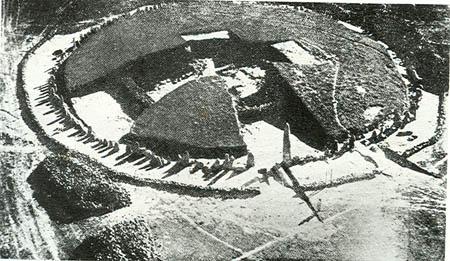192: The Morrocan Giant
- IJ
.jpg/v1/fill/w_320,h_320/file.jpg)
- Dec 3, 2022
- 3 min read
When the Roman commander Quintus Sertorius arrived in Tingis (Tangier, Morocco) in 81 BC, the locals showed him a huge mound said to be the grave of Antaeus, the city’s famous founder. In Greek myth, Antaeus was a giant of North Africa notorious for his compulsory wrestling contests. Every opponent succumbed to his lethal grip. That is, until the Greek strongman Heracles took up the challenge and slew Antaeus. According to the locals, Heracles then took up with Antaeus’s giant widow, Tinga, and fathered Sophax, the city’s first king. Skeptical, Sertorius ordered his soldiers to dig up the mound.

Sertorius was so gob smacked by the enormous skeleton that emerged under the men’s shovels that he personally affirmed the Tingis legend and reburied the giant Antaeus with great honors. According to Plutarch’s biography of Sertorius and the geographer Strabo, the skeleton in the mound was 60 cubits long, about 85 feet (26 meters).
Modern commentators have sarcastically dismissed the possibility that the Romans could have discovered such a vast skeleton. They assert that Plutarch’s narrative simply shows how Sertorius cleverly manipulated the beliefs of the ignorant Moroccans. But until now, no one troubled to check the paleontology of North Africa. In fact, the Antaeus incident is an important milestone in paleontological history. Sertorious’s investigation of the Tingis folklore claim is the earliest recorded deliberate excavation of the significant Pliocene-Miocene (Neogene) fossils of Morocco. The local story about the giant Antaeus was consistent with the traditional geographical distribution of the extinct race of giants in Greek mythology, and it also turns out that the location of immense bones’ corresponds to actual fossil beds in the region.... (It seems odd then than that mastodons partook in wrestling matches... and that human as intelligent as the Greeks couldn't tell a human from an elephant! Think about that one carefully. This is the Greeks we are talking about, not some stone age tribe.)
Ancient historians Gabinius and Strabo tell us that the giant was unearthed in Lixus (modern Larache) about 40 miles south of Tingis on the Atlantic coast. Pliny also placed Antaeus’s remains in Lixus, but refused to write down any of the region’s “fantastic” legends, complaining that the native words “are absolutely unpronounceable.”
The so called “Cromlech de Mzoura” or “circle of Larache” is one of the most famous and largest megalithic landmark of the north-west of Morocco, North Africa. “Mzoura” (in Arabic means “The Holy Place”) can be found about 15 km south of the harbor of Asilah not far from Tangier. The elliptical-shaped tumulus at Mzora has 55 meters (177 feet) in diameter and is surrounded by 167 stone monoliths, of which the tallest, is about 5m (3.2 feet) high.
The locals say that it has approximately 7 meter long stone “root” below the surface. The megaliths were hammered and polished by hand. Their arrangement forms a perfect elliptic structure.

The ancient site was excavated in 1939 by the French where a tomb was discovered under one of mounds. Inside the tomb photo taken in 1939 or so notice the spiral theme going on which we see on Malta, Spain, France, Ireland etc.

The most striking alignment of Mzoura stone circle is the main axis to the largest mountain on the horizon, and the east-west alignment of the ellipse marks the path to the setting equinoxes of spring and autumn.
























































Comments